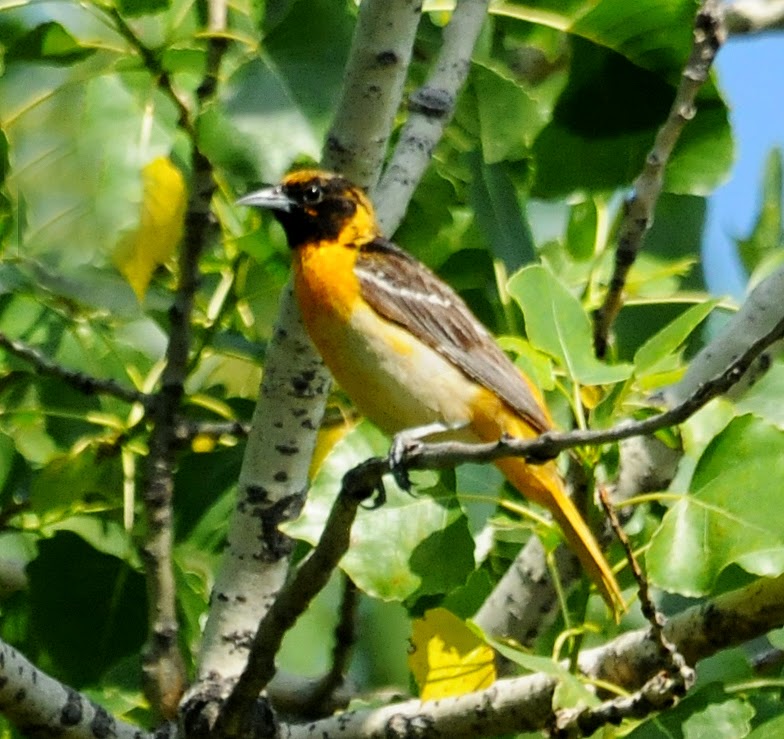Bullock's Oriole x Baltimore Oriole hybrid, Tamarack Ranch, Logan County (Colorado, USA), 25th May 2014 - copyright Steve Mlodinow
(photo ID: 1590)
Steve reckons that in eastern Colorado the proportion of Bullock's/Baltimore Orioles that are hybrids is in the region of 20%.
Bullock's Oriole x Baltimore Oriole hybrid, north of Wray, Yuma County (Colorado, USA), 23rd May 2014 - copyright Steve Mlodinow
(photo IDs: 1588-1599)
Steve explains that the next female was coloured more like a Baltimore Oriole but has the face pattern of a Bullock's. He says it's hard to be certain that it's a hybrid but it seems quite likely.
probable Bullock's Oriole x Baltimore Oriole hybrid, Wray, Yuma County (Colorado, USA), 25th May 2013 - copyright Steve Mlodinow
(photo IDs: 1162-1164)
The next male is a bit more straightforward with pretty obvious intermediate characters.
Bullock's Oriole x Baltimore Oriole hybrid, Prewitt Reservoir, Washington County (Colorado, USA), 12th July 2012 - copyright Steve Mlodinow
(photo IDs: 1259-1261)
Next up is a very Baltimore Oriole like bird, but Steve points us to the prominent white edging on the greater coverts, resulting in a pattern that is intermediate between Bullock's and Baltimore Orioles. There's also a bit of orange near the eye, a mark that should not be present on a 'pure' Baltimore Oriole.
Bullock's Oriole x Baltimore Oriole hybrid, Prewitt Reservoir, Tamarack Ranch, Logan County (Colorado, USA), 25th May 2012 - copyright Steve Mlodinow
(photo ID: 1271)
Here's another fairly obviously intermediate bird:
Bullock's Oriole x Baltimore Oriole hybrid, Crow Valley Campground, Weld County (Colorado, USA), 24th May 2012 - copyright Steve Mlodinow
(photo IDs: 1282-1283)
The next one is presumably a first-year male, in an area which Steve tells us had a numnber of hybrid orioles with a wonderful array of phenotypes.
Bullock's Oriole x Baltimore Oriole hybrid, Tamarack Ranch, Logan County (Colorado, USA), 2nd July 2011 - copyright Steve Mlodinow
(photo ID: 1396)
Bullock's Oriole x Baltimore Oriole hybrid, St Francis, Cheyenne County (Kansas, USA), 8th June 2015 - copyright Steve Mlodinow
(photo ID: 2261)
Bullock's Oriole x Baltimore Oriole hybrid, Neenoshe Locust Grove, Kiowa County (Colorado, USA), 30th August 2015 - copyright Steve Mlodinow
(photo ID: 2282)
The next one looks much like Bullock's Oriole but Steve points out the face is olive, the chest brighter, and there is no hint of eyeline. The grey back and overall dull coloration points away from Baltimore Oriole.
Bullock's Oriole x Baltimore Oriole hybrid, Frenchman Creek SWA, Phillips County (Colorado, USA), 23rd May 2015 - copyright Steve Mlodinow
(photo ID: 2255)
Bullock's Oriole x Baltimore Oriole hybrid, location not given (Colorado, USA), 10th May 2008 - copyright Christian Nunes
(photo IDs: 2329-2331)
Steve tells us that pure Baltimore Orioles are somewhat rare this far west, as are hybrids.
Bullock's Oriole x Baltimore Oriole hybrid, Union Reservoir, Weld County (Colorado, USA), 2nd July 2016 - copyright Steve Mlodinow
(photo IDs: 2865-2866)
Females are inevitably trickier to identify with confidence and it's no surprise that some people view records with scepticism. Steve writes:
"Whenever I suggest that a female oriole is a hybrid, I receive pushback from experienced birders. I've not been able to photograph a female that seems to make most birders happy that it is a hybrid. Yet, give the number of male Bullock's Oriole x Baltimore Oriole hybrids that occur in easternmost Colorado, there has to be females. This bird has an orange chest, the brightest part of the bird, like a Baltimore Oriole. Yet it also appears to have a darkish line through the eye, a hint of a supercilium and some dusky on the crown: reminiscent of a Bullock's Oriole . The back color seems more Bullock's Oriole like, the facial color dullish, like a Baltimore Oriole, and the serrated upperwing bar is kind-of separated. So, methinks this is a hybrid."
His logic makes sesne to me... what do you think?
Bullock's Oriole x Baltimore Oriole hybrid, Lion's Fishing Hole, Holyoke, Phillips County (Colorado, USA), 28th August 2016 - copyright Steve Mlodinow
(photo IDs: 2867-2868)
Bullock's Oriole Icterus bullockii
Baltimore Oriole Icterus galbula























































